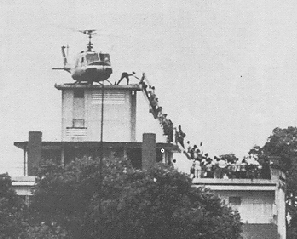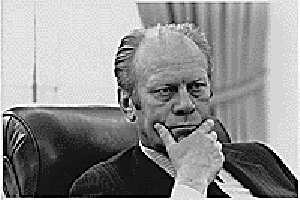
|
|
|
|
|
|
|
|
|
|
|
|
|
| The fall of Saigon marks the fall of South Vietnam to Communist North
Vietnam. It also marks a humiliating loss for the United States full regrets.
Most painful though, it marks memories of terror and despair for the South
Vietnamese as they tried to evacuate the city as the VietCong marched towards
it. It reminds everyone of lives lost, hopes and dreams shattered, and
innocence stolen. It is a period of history which is yet to be fully recovered
from.
|
 |
When President Richard M. Nixon took office in 1969, he had inherited a war that put over half a million in uniform. There was heavy protestation to America's involvement in the Vietnam War and even the bullish advisors suggested that the United States would still need to be in Vietnam for another eight years to settle peaceful negotiations. President Nixon did not want to be so entangled in the war. He began phasing out the draft and started gradually withdrawing troops, but still send money, weapons, and advisors to South Vietnam. A final peace agreement was made in January of 1973. Nixon claimed this to be a way of achieving peace with honor. Really, it was a way for America to get out more safely and to try to save face. Nixon had initiated "Vietnamization," a program which involved gradual to increased withdrawal while teaching the South Vietnamese ARVN forces how to better defend themselves, but there was little involvement in South Vietnam after this agreement.
In the meantime, South Vietnam was left to fight off the VietMinh themselves. They had hoped to negotiate with North Vietnam, but without any great success or the support of the United States, South Vietnam did not have anything to bargain with. In the beginning of 1975, the North Vietnamese started marching down the Ho Chi Minh Trail, their last attack of the war. By the end of April that year, Saigon fell.
Although the United States was not real active in the Vietnam War after 1973, the U.S. was still involved. North Vietnam had a number of American POW's and MIA's. The Ambassador to South Vietnam, Graham Martin, worked hard with South Vietnam's President Thieu, who still had faith that the United States would come to South Vietnam's aid.
President Thieu had been assured and reassured that they had an ally
in the United States. When Gerald Ford took office after Nixon resigned,
he became the first United States President to have never been elected.
Although other Vice Presidents have had to take the Presidency mid-term,
Ford was the first to have not been elected to the Vice Presidency. He
went to great lengths to assure his allies, that although he had not been
elected, he intended to continue the policies of his predecessor. He wrote
letters to all these allies, including President Thieu, who became extremely
excited, believed this was a personal letter declaring U.S. interest in
being involved in South Vietnam.
 |
The United States, as a whole, was not as interested as Thieu believed. When Thieu saw he was in dire need of aid, Ford did want to give it to him. The Senate however believed such aid would be futile and useless and therefore decided not to send it. There was nothing President Ford could do. President Ford was distraught, afraid to be remembered as the President who saw both South Vietnam and Cambodia (a neighboring nation also that along with Laos and Vietnam had made up the French Indochina which was simultaneously falling to the Communist Khmer Rouge.) |
While over one hundred thousand North Vietnamese were infiltrating South Vietnam via the Ho Chi Minh Trail, the ARVN soldiers were retreating south. South Vietnamese were terrified, fleeing to Danang, overcrowding the city so much that there were even a number of people living on the air strips. But the people there started to worry that they were not safe in Danang so they tried to leave Danang and head for Saigon.
Traveling from Danang to Saigon required flying. Some famous wealthy people volunteered their private planes for the purpose of evacuating refugees, including Ross Perot and Hugh Hefner, whose plane was even flighted by bunnies. The ARVN forces in Danang started worrying about their safety as well, realizing that with all the civilians gone, once the North Vietnamese reached Danang, there would not be anyone there besides themselves. The ARVN desperately started to beat off the civilians so that they could board the planes themselves. The evacuation of Danang was a bloody mess.
The situation in Saigon was just as dire and just as chaotic. People were frantic. The United States was desperate too, with Operation Frequent Wind, the plan to evacuate, in full swing. Much of Saigon at this time was very much a ghost town. Refugees had begun poring into the city, living in abandoned buildings. The VietCong had taken Saigon. President Thieu had ordered the ARVN forces to fight to the death. Instead, they surrendered quite easily. President Thieu resigned on April 21, 1975. On April 29, 1975, Duong Van Minh, "Big Minh," became the new President of South Vietnam. Big Minh waited to resign. Big Minh surrendered the government of South Vietnam on April 30, 1975. On May 1, 1975, Saigon was renamed Ho Chi Minh City.
Operation Frequent Wind had successfully moved over 50,000 people, including 7,806 U.S. citizens. South Vietnamese risked life and limb to evacuate, or to at least evacuate their children. The United States took in numerous Vietnamese refugees; most of them babies to be adopted into American families. Those who were lucky enough to evacuate underwent quite an ordeal to do so. The Americans were taken first, leaving the South Vietnamese to risk life and limb to evacuate. They took such extreme measures in attempting to leave, like hanging from the skid of the helicopter. Those who did evacuate were flown to nearby ships. Some left onland tried to swim out to the ships. Many died in the process of trying to escape. Unfortunately, Operation Frequent Wind left behind South Vietnamese, who had sacrificed greatly for the United States. Those left behind were rounded up and shot by the North Vietnamese.
There was no happy ending to the Vietnam War. The fall of Saigon marked
the end of the Vietnam War, a painful loss for all involved. It was a humiliating
loss for the U.S. It was not until twenty years later, in 1995, that President
Bill Clinton recognized North Vietnam as the sole government of Vietnam.
Bitter memories have made and still make it very hard for all to move on.
The fall of Saigon is a significant part of American history. It finalized a war that had changed society and proved that the invincibility America felt was totally inaccurate. America invested greatly to stop the spread of Communism. America was distraught in 1949, when China fell to Communism, an event that heightened the Cold War. The threat of Vietnam falling meant the threat of Laos, Cambodia, India, and others falling, as the domino theory had suggested. Nobody expected the outcome to be one of defeat. The domino theory ended up being just that, a theory. Meanwhile, the significance of the fall of Saigon for the Vietnamese is even greater. Both North Vietnam and South Vietnam suffered more casualties than the United States. And unlike the United States, the war was fought on their turf, and much land was destroyed because of it. The fall of Saigon was only twenty-six years ago, which is shorter than American involvement in the Vietnam Conflict (both diplomatically and militarily.) So it is fair to believe that the lasting impact of the war, and the significance of the fall of Saigon are yet to be determined.
Bender, David L. The Vietnam War: Opposing Viewpoints. Greenhaven
Press, Inc. San Diego, CA: 1998
Brown, Weldon A. The Last Chopper. Kennikat Press Corp. New
York/London: 1976
Herring, George C. America's Longest War: The United States and
Vietnam, 1950-1975. McGraw-Hill Inc. U.S: 1996.
Hosmer, Stephen T. The Fall of South Vietnam. Crane, Russak,
and Company. New York: 1980
Le Gro, Col. William E. Vietnam From Cease-Fire to Capitulation.
Library of Congress
http://www.fallofsaigon.org U.S. Marines site on the fall of Saigon
http://www.fas.org/man/dod-101/ops/frequent_wind.htm Federation of American Scientists site on the fall of Saigon
http://www.scarface-usmc.org/1975_the_evacuation.htm U.S. Marine helicopter squadron site on Saigon evacuation